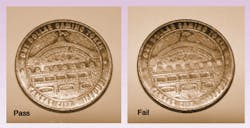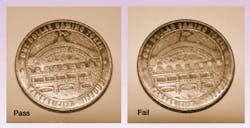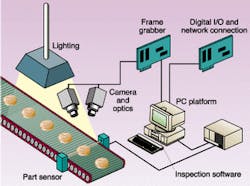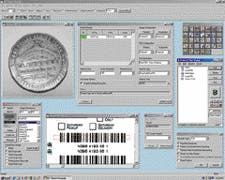Automated inspection saves casino money
John A. Little
While human eyes, hands, and brains make up quite a sophisticated neurological network that enables us to inspect and sort objects, we fall short in two areas: we are relatively slow compared to automated inspection systems, and fatigue impairs our ability to distinguish an acceptable object.
In competitive markets, the key to gaining advantage is to drive down the cost per unit without sacrificing quality. Reduced inspection quality and associated speed limitations caused by fatigue add significantly to the production costs, particularly for products produced in high volumes or at high rates.
This fact, combined with concern about possible repetitive-motion injuries to employees, is driving manufacturers to develop alternative inspection, sorting, or quality processes for high-volume, highly repetitive production lines. This is where machine vision comes into play.
Inspecting casino tokens
Late last year, machine-vision systems designers at Vision 1 (Bozeman, MT) were presented with a demanding and interesting challenge. The potential client, a major processor of metal gaming tokens used in casinos throughout the world, offers a service to its market of sorting tokens to determine those that are either too worn for use or are no longer being used by a particular casino from those that are still good (see Fig. 1). The client receives a commission for each good token found. The company decided to investigate machine vision because it found human inspectors too slow and too expensive. Additionally, the company discovered that too many good tokens were being scrapped and too many bad ones were being passed as good.
The performance goals for a prospective machine-vision system encompassed a range of factors. The coins had to be sorted at speeds faster than can be accomplished by human beings, who generally sort at the rate of 0.5 to 1 token per second. The sort included comparing each token with a "golden template, " or new copy of the coin of interest for the current sort and the sort had to be accurate regardless of whether the reverse or obverse side of the coin was exposed to the camera. The system had to err on the side of rejecting good coins while being adaptable to sort different tokens by simply replacing the template with a different token, so that it could handle an array of coin styles. The system also had to be easy to train by the operator and had to provide an output TTL (transistor-transistor-logic) pulse when it detected a bad (mismatched) coin.
Configuring the system
The Vision 1 team then developed a single modular solution, which consisted of a PC, a digital camera and appropriate lighting (see Fig. 2). The single module was designed to image and process coins at a rate of five Eisenhower-dollar-sized coins per second. A main component of any machine-vision system is the software, which essentially determines how well the brains of the system can think. The "Image Classifier" tool from Vision Foundry (Data Translation; Marlboro, MA) was chosen as the "engine" of the machine vision system because it uses an algorithm based upon information theory that enables fast and accurate grayscale image comparisons (see Fig. 3).
The camera chosen was a JAI CVM-10, which is a progressive scan 640 x 480 pixel, 0.5-in. CCD, monochrome camera. It was chosen for the application because it is economical and easy to manually configure (dip switches may be externally set to control shutter speed, scan type, trigger, asynchronous reset, gain correction, and so on). A line scan approach would have meant a more expensive camera and a mechanically more complex coin feeding technique. The goal was to minimize the complexity and cost of the system while providing as much performance as possible.
A single camera met the requirements for this application. Implementing a second camera would reduce cycle time per coin, however the processing power of the PC was already largely consumed by the single camera approach.
For very high-rate production systems, a high frequency fluorescent ring light is frequently required, but in this case the proof-of-concept system succeeded with low frequency fluorescent lighting. High-frequency fluorescent light, typically in the 10- to 20-kHz frequency range, reduces interference problems that are encountered as camera exposure times become very small. The illumination was placed close to the coins to maximize feature contrasting for pattern detection and analysis.
Meeting the challenges
An important application challenge was to optimize the image such that the "classifier" speed and accuracy were maximized. The key elements to maximizing these variables were first, to optimize the field of view (FOV) to the coin: if the coin occupied too much of the FOV, the time to process would increase. If the coin was too small, identification accuracy would be adversely affected. And second, to constrain perpendicular motion, to the axis of travel, of the coin as it passed under the camera: the application was invariant to coin rotation as well. However, if rotation orientation could have been controlled, processing time would have been reduced.
Because different tokens have different thicknesses, the optics were focused by the operator one time for each type of token being inspected. For convenience of operation, live video was used to focus and align the cameras.
Each module was designed to accept a TTL in-put trigger, which comes from a part sensor that indicates that a token is in position to start the image capture. After the image capture step, analysis of the image using Vision Foundry was performed, and a TTL output signal was generated if a mismatch was detected. If the coin did not match the template, it would be rejected. A rejection could occur if the coin was too worn, or if it came from another casino.
The software provided the operator with the means to easily train the system to recognize the coin of interest. In this case, the user presented several good tokens to the system (both sides) for training. Vision 1 and Data Translation then developed the application to detect only one token type at a time. After the system is trained, it passes coins matching the "pass" criteria and rejects all others.
The final system design met all of the pre-established performance goals for dollar-sized tokens. It was at least five times faster than a human being. System recognition accuracy was superior to human performance, and unlike a person, the tool could operate 24 hours a day, seven days a week without any degradation in accuracy or inspection throughput.
A machine vision system is only as good as its weakest component and only as accurate as the information it receives. Spending the time and effort to carefully select the components is essential for a successful machine vision inspection.
JOHN A. LITTLE is director of sales and marketing at Vision 1, 151 Evergreen Drive, Bozeman, MT 59715; e-mail: [email protected].



